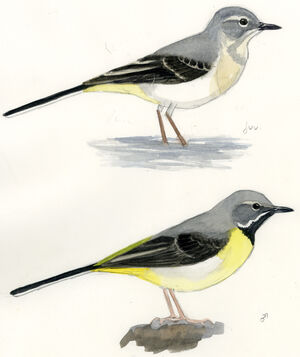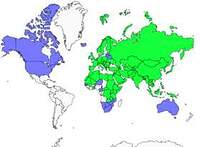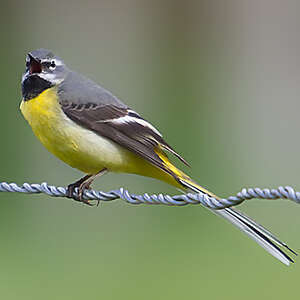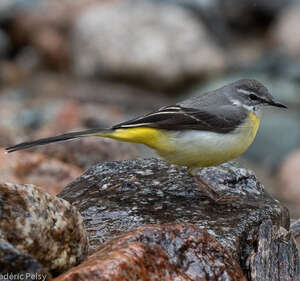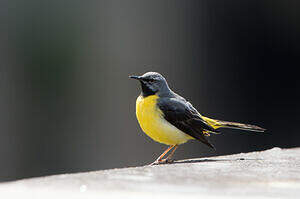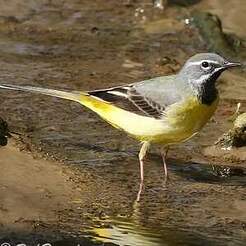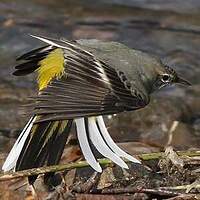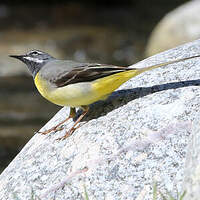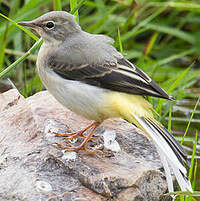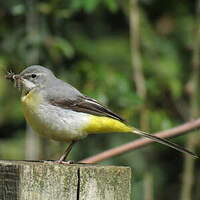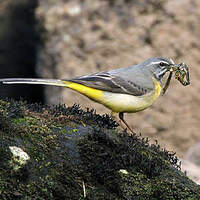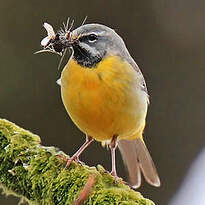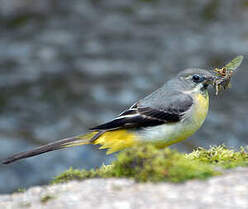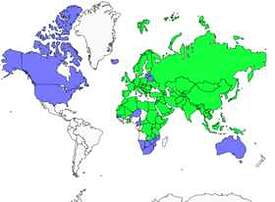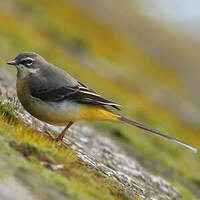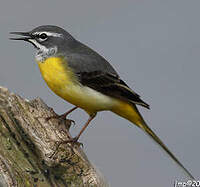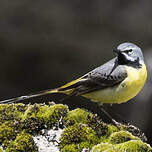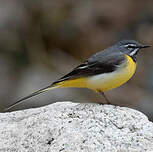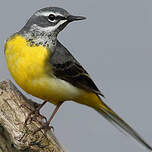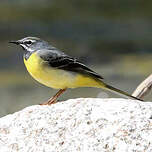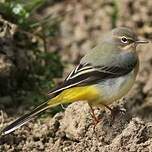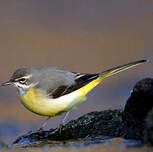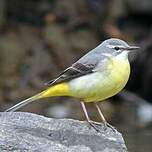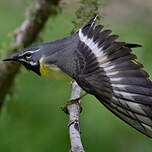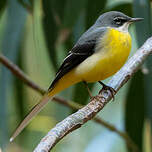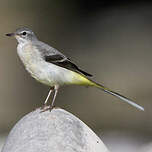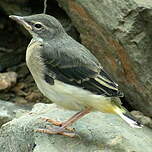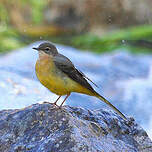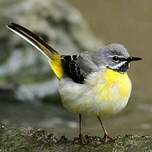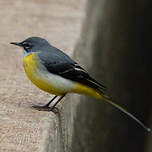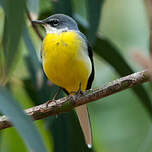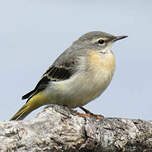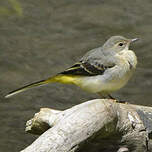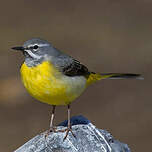Grey Wagtail
Motacilla cinerea - Bergeronnette des ruisseaux
Identification
It is suggested that confusion could arise between the Grey Wagtail and the Pied Wagtail. In my opinion, when closely observed, this only happens with first-year birds, and even then. The Grey Wagtail exhibits sexual dimorphism. The breeding male is easily identified by its black bib. The head is grey-brown. The dark eye has two white supercilliary arcs above and below. The upper arc merges into a distinctive white eyebrow. The lores are black. Two broad white moustaches border the black bib. The bill is black. In winter, the male loses its black bib, resembling a female, though it is paler blue-grey underneath. The best specific criterion is the colour of the upper part. The mantle, back and part of the wings are grey. This criterion alone eliminates possibilities of a Pied Wagtail. The rump and tail-centres are yellow-olive. The lower parts are yellow, with the flanks paler, if visible. The dark remiges have white bases, which are easily visible in flight. The tail is very long, proportionally much longer than the Pied Wagtail. It is black in the centre with three pairs of external rectrices white, clearly visible in flight. The legs are pinkish-brown. The breeding female resembles the male but has no black bib; she has only some small grey-brown spots. In winter her lower parts are noticeably less yellow except for the tail-centres. The flanks are whitish. The juvenile resembles a pale female. The grey of the upper parts is slightly tinged with olive. The underside is whitish with the breast, if visible, cream to pale salmon. The specific criterion is that the yellow is confined to the tail-central area. A juvenile Pied Wagtail would appear browner in tone with a more distinct eyebrow, and would lack any yellow colouration.Its tail is also much shorter.
Subspecific information 3 subspecies
- Motacilla cinerea cinerea (w Europe, Canary Is. and nw Africa to c, e, ne Asia.)
- Motacilla cinerea patriciae (Azores)
- Motacilla cinerea schmitzi (Madeira)
Foreign names
- Bergeronnette des ruisseaux,
- Lavandera cascadeña,
- alvéola-cinzenta,
- Gebirgsstelze,
- hegyi billegető,
- Grote Gele Kwikstaart,
- Ballerina gialla,
- forsärla,
- Vintererle,
- trasochvost horský,
- konipas horský,
- Bjergvipstjert,
- virtavästäräkki,
- Gryskwikkie,
- cuereta torrentera,
- Straumerla,
- pliszka górska,
- pelēkā cielava,
- siva pastirica,
- Горная трясогузка,
- Kicuit batu,
- キセキレイ,
- 灰鹡鸰,
- นกเด้าลมหลังเทา,
- 灰鶺鴒,
Voice song and call
The flight call is a loud and resonant tjip, often doubled as tjitip, and the bird is not reluctant to use it. You can also hear the rapid tsi ti ti tip or the iiisst. The song is made up of repeated high-pitched, very loud notes, often in sequences of three to five and with a variable rhythm, tsi si si si sih, si si si, ti ti ti ti ti or tsi tsi tsi tsi tsi up to the trill of titititititi. The singer can be heard from a singing spot such as a rock, branch, wall or other. It also often sings in territorial flight, a bit like a pipit. The power and frequency of the voice allow the singer to be heard despite the noise of the water flow. The habitat can help with identification since generally there is water nearby. But this is not always the case, especially among migrants flying over land. Confusion can arise from the cries that are reminiscent of those of the Grey Wagtail, often seen near water as well. Its usual call is also a djitip, but less striking. It takes some getting used to.
Habitat
The Grey Wagtail is very dependent on water, especially running water. It usually searches for its food near the water, and even in shallow water.
Behaviour character trait
Often all you need to do is stand on a bridge and observe the river to spot a Grey Wagtail. It stands out with the way it meanders along the water's edge, and the impressive length and striking mobility of its tail feathers which flap repeatedly.
Wasn't it known as a 'wag-tail' in former times? This species certainly fits the bill. Notice also the bright yellow plumage of adult birds. In spring it's often the male's voice which catches the ear, a melancholic yet piercing tone of song which any attentive observer would hear. In France it's present year-round, with some birds being sedentary or even nomadic. Altitude species will sometimes descend into the lowlands to avoid the worst of the coldness of winter. It's also surprising to find that, given its rather modest wingspan and big tail, it's actually a great long-distance migrator in the eastern part of its range, covering thousands of kilometres to reach its wintering grounds and then come back.Dietfeeding habits
The Grey Wagtail is linked to free water, mainly flowing. It feeds on the ecotone water-land by drawing from both enviroments.
It can also frequent artificial environments, especially in the bad season, fish farms and other, lagunages, etc. They are insectivorous in the general sense. It is mainly fed by aquatic insect larvae and ephemeroptera, trichoptera, plecoptera, odonata, chironomid diptera, etc. It also captures gammaines, amphipod crustaceans and small mollusks. To do this, it wanders in shallow water or hunts on the nearby land. Exclusively terrestrial prey is also captured, coleoptera, orthoptera, spiders, etc. It is capable of capturing insects in flight from the ground or a perch, for example at the time of emergence. The young are of course fed insects.Reproduction nesting
The breeding season of the Grey Wagtail extends from March to August on a geographical scale, depending on latitude and altitude.
In Western Europe, it starts as early as March with the re-establishment of territory and courtship. The nesting itself begins in April and there is temporally room for a second clutch. This wagtail is monogamous and highly territorial. This is imposed on it by the restriction of habitat and resource. The male fiercely defends its territory with its singing and associated territorial flights. When perching, it crouches with wings and tail open and low, displaying the yellow, ruffled belly feathers as a visual signal. The nesting site has been described in the Habitat chapter. The nest, built by both adults, is made of strands of grass, small roots, moss, leaves and the cup is lined with a fine bed of vegetable fibers, hair and down. The female lays 4-6 eggs (3-7) which the parents incubate for 12-14 days. They also share the care of feeding the chicks in the nest for another 12-13 days. The juveniles take flight 2-3 weeks after hatching. The adults can then consider a second nesting.Geographic range
The Grey Wagtail's range extends from the Atlantic Islands (Canary Islands, Madeira, Azores) to the far east of Russia throughout Eurasia at middle latitudes. The continental range and Canary Islands are occupied by the nominate subspecies cinerea. Madeira hosts the subspecies schmitzi and 2 of the Azores Islands the subspecies patriciae. It is well represented and sedentary in Western Europe. It is quite local and migratory throughout the Scandinavian Peninsula. It is only present in the mountains of the Maghreb, mainly Morocco. On the other hand, it is well present in winter. It is absent from the steppes and deserts of Central Asia as well as from the Tibetan plateau. It can be found in the mountains (Tian Shan, Pamir, Himalayas...), of course migratory. All continental populations, Russian, Mongolian and Chinese, are migratory and will spend the winter far to the south, around the Red Sea, the Persian Gulf, in India, South East Asia and Indonesia.
Threats - protection
IUCN conservation status
concern
in the Wild
threatened
evaluated
The Grey Wagtail is a widely spread and regular bird in its habitat. It is not globally threatened. Even the island populations are doing well. There is even a recent expansion, especially in Scandinavia, probably related to climate change.
Sources of information
- IOC World Bird List (v14.2), Gill, F and D Donsker (Eds). 2024-04-18.
- Pipits and Wagtails of Europe, Asia and North America, Alström Per and Mild Krister
- Les passereaux d'Europe, tome 1, P. Géroudet, M. Cuisin
- Avibase, Lepage Denis
- Birds of the World, The Cornell Lab of Ornithology
- xeno-canto, Sharing bird sounds from around the world,
Other sources of interest
 Specification sheet created on
13/07/2023 by Jean François
Specification sheet created on
13/07/2023 by Jean FrançoisTranslation by AI Oiseaux.net
© 1996-2025 Oiseaux.net
- Accipitriformes
- Aegotheliformes
- Anseriformes
- Apodiformes
- Apterygiformes
- Bucerotiformes
- Caprimulgiformes
- Cariamiformes
- Casuariiformes
- Charadriiformes
- Ciconiiformes
- Coliiformes
- Columbiformes
- Coraciiformes
- Cuculiformes
- Eurypygiformes
- Falconiformes
- Galliformes
- Gaviiformes
- Gruiformes
- Leptosomiformes
- Mesitornithiformes
- Musophagiformes
- Nyctibiiformes
- Opisthocomiformes
- Otidiformes
- Passeriformes
- Pelecaniformes
- Phaethontiformes
- Phoenicopteriformes
- Piciformes
- Podargiformes
- Podicipediformes
- Procellariiformes
- Psittaciformes
- Pterocliformes
- Rheiformes
- Sphenisciformes
- Steatornithiformes
- Strigiformes
- Struthioniformes
- Suliformes
- Tinamiformes
- Trogoniformes

